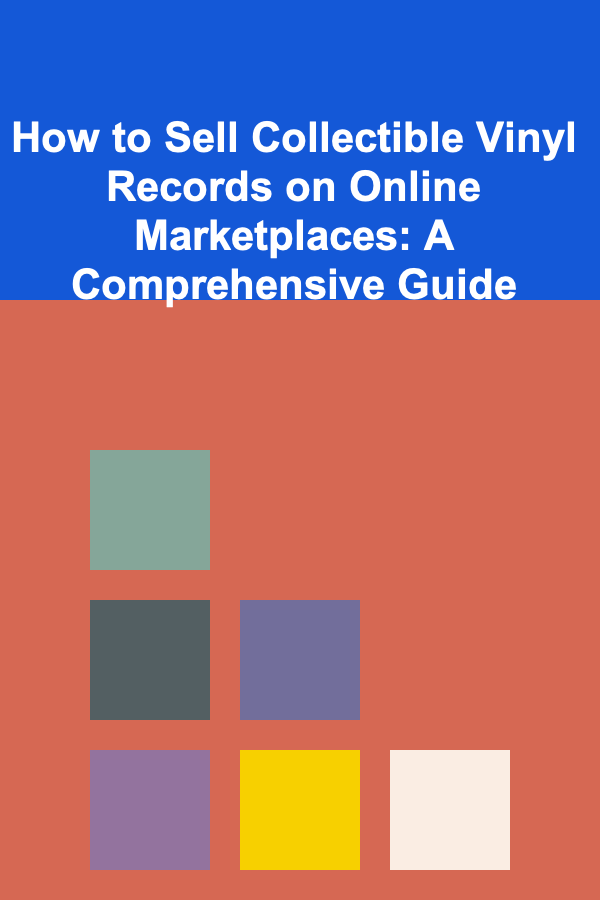
How to Sell Collectible Vinyl Records on Online Marketplaces: A Comprehensive Guide
ebook include PDF & Audio bundle (Micro Guide)
$12.99$6.99
Limited Time Offer! Order within the next:

Selling collectible vinyl records on online marketplaces can be a rewarding venture for music lovers and entrepreneurs alike. Vinyl records have seen a resurgence in popularity over the past few years, attracting both nostalgic listeners and new collectors. Whether you are looking to downsize your collection or start a vinyl-selling business, online platforms like eBay, Discogs, and Etsy offer a great opportunity to reach a global audience.
However, selling vinyl records online requires a careful, strategic approach. Collectible records are unique in that their value is heavily influenced by factors such as rarity, condition, and demand. This guide will walk you through everything you need to know about selling collectible vinyl records on online marketplaces.
Step 1: Understand the Collectible Vinyl Market
Before you start selling, it's crucial to understand the market for collectible vinyl records. The demand for vinyl has grown over the past decade, but not all records are created equal. Some genres, pressings, and artists have a higher level of demand and value than others.
1.1 Identifying Collectible Records
Not all vinyl records are valuable or considered collectible. Here are some key features that typically increase the value of a record:
- Limited Editions and Special Releases: Records released in limited quantities or as special editions (e.g., colored vinyl, picture discs, numbered pressings) are often more valuable.
- First Pressings: The first pressing of a record is often more valuable to collectors, especially if it was released during the artist's prime.
- Artist Signatures: Signed records can increase in value, particularly when signed by the artist or band members.
- Rare Genres and Albums: Certain genres, such as classic rock, jazz, soul, and punk, are often in higher demand, and albums by iconic artists or bands will attract more buyers.
- Condition: The condition of the vinyl and its packaging plays a huge role in determining its value. Well-maintained records in near-mint condition are worth more than records that are scratched, warped, or have damaged covers.
1.2 Researching the Market Value
Research is essential to determining how much your collectible records are worth. Here are some tools and strategies you can use to research the market value:
- Discogs: Discogs is a fantastic resource for researching vinyl records. The platform features a comprehensive database of vinyl pressings, including pricing history, album details, and condition guides. Use Discogs to check the current market value of a record.
- eBay: eBay's "sold listings" feature allows you to see the actual prices that similar records have sold for. This can help you gauge the demand and pricing trends for specific albums.
- Record Shops and Price Guides: If you're unfamiliar with the value of certain records, you can consult printed price guides or visit local record stores to ask about specific albums. Many independent record shops will also help you identify and price valuable records.
Step 2: Prepare Your Vinyl Records for Sale
Properly preparing your vinyl records for sale is crucial to presenting them in the best possible light. The condition of the vinyl, the sleeve, and any additional packaging (like inserts or posters) can all affect the price and desirability of the record.
2.1 Clean Your Vinyl Records
Before listing your vinyl records, make sure they are clean and free of dirt or dust. Dirty records can lead to poor sound quality and a negative buying experience. Here's how to clean your records:
- Use a Record Cleaning Solution: Invest in a record cleaning solution and a microfiber cloth or brush. Apply the solution to the vinyl and gently wipe the surface in a circular motion, following the grooves of the record.
- Invest in a Record Cleaning Machine: For serious sellers, a record cleaning machine can be a worthwhile investment. These machines provide a deep clean and can remove stubborn dirt and static from your records.
2.2 Inspect the Condition of Your Records
Buyers are highly particular about the condition of vinyl records, so it's essential to accurately assess and describe the condition of each album. Follow these guidelines for grading the condition of your vinyl and its packaging:
-
Vinyl Grading : Vinyl condition is usually graded on a scale from Mint (M) to Poor (P), with several gradations in between (NM, VG+, VG, G, etc.). Familiarize yourself with these grades to ensure accurate descriptions.
- Mint (M): The record is in perfect condition, with no visible flaws.
- Near Mint (NM): The record shows no obvious signs of wear but may have slight imperfections that don't affect play.
- Very Good (VG): The record may have minor scratches or wear but plays without major issues.
- Good (G) and Below: Records with scratches, scuffs, and noticeable imperfections that impact sound quality. These should be listed honestly with the exact details of any flaws.
-
Cover Grading: Grading the album cover is just as important. Common grades for covers include:
- Mint: The cover is in perfect, brand-new condition.
- Near Mint: The cover shows no obvious signs of wear but may have slight imperfections (e.g., a small crease or a scuff).
- Very Good: The cover has noticeable wear, like edge creases, seam splits, or ring wear.
- Good/Poor: Significant damage such as large tears, water damage, or excessive wear.
2.3 Take Quality Photos
Clear and high-quality photos are essential when selling vinyl records online. Buyers want to see exactly what they are purchasing. Here's how to take great photos of your records:
- Photograph the Record: Capture the vinyl itself, both front and back, to show the condition of the grooves. Be sure to show any imperfections like scratches or scuffs.
- Photograph the Cover: Include photos of the front and back covers, highlighting any damage or wear. Take close-ups of corners, seams, and spine areas.
- Include Additional Materials: If your record comes with inserts, posters, or other additional materials, photograph these as well.
2.4 Create Detailed Descriptions
Your listing description should include all relevant details about the vinyl record. A thorough description builds trust with potential buyers. Here's what to include in your description:
- Album Title and Artist: Be specific and include the album title, artist, and any notable details (e.g., first pressing, limited edition, etc.).
- Label and Catalog Number: Include the record label (e.g., Columbia, Capitol, etc.) and the catalog number, which helps buyers verify the exact pressing.
- Condition: Describe the condition of both the vinyl and the cover using the grading system. Be honest about any flaws.
- Release Year and Pressing Info: Include the release year and any information about the pressing, such as whether it's a first edition or a reissue.
- Additional Notes: If there's something special about the album (like it being signed or being part of a collector's set), make sure to mention it.
Step 3: Choose the Right Online Marketplace
Now that your records are ready, it's time to choose the best marketplace for selling. Different platforms have different strengths, so it's important to select one that aligns with your goals.
3.1 eBay
eBay is one of the most popular online marketplaces for vinyl records. It offers both auction and fixed-price listings, which allows you to choose whether to let the market set the price or to sell at a fixed amount.
- Pros: eBay has a huge, global audience, which increases your chances of finding a buyer. Its auction format is particularly useful for rare or valuable records.
- Cons: eBay's fees can add up, and you may need to deal with returns or disputes.
3.2 Discogs
Discogs is a dedicated platform for music collectors and vinyl enthusiasts. It is one of the best platforms for selling collectible vinyl records, and it has a comprehensive database of album information.
- Pros: Discogs is widely respected within the vinyl community and attracts serious collectors. The platform's detailed database allows for accurate pricing and information.
- Cons: Listing fees are involved, and the platform can be a little more niche, meaning there may be fewer casual buyers compared to eBay.
3.3 Etsy
Etsy is known for handmade and vintage items, including vinyl records. It's a great platform for selling vinyl records if you are targeting collectors looking for unique or vintage pieces.
- Pros: Etsy has a strong community of buyers who appreciate vintage items. Its fees are generally lower than eBay's.
- Cons: Etsy is not as specialized for vinyl records as Discogs, and competition from other vintage sellers can be high.
3.4 Facebook Marketplace and Local Platforms
For those who want to avoid shipping costs or target local buyers, Facebook Marketplace and other local selling platforms like OfferUp and LetGo can be effective.
- Pros: You can sell locally, avoiding shipping and reaching buyers who want to see the records in person.
- Cons: Limited to local buyers, which may reduce your reach compared to global platforms like eBay or Discogs.
Step 4: Handling Shipping and Customer Service
Once you have made a sale, the final step is to ship the record to the buyer. Proper packaging is essential to prevent damage during transit. Use stiff cardboard to protect the vinyl, and consider using a mailer designed specifically for records.
4.1 Shipping Considerations
- Packaging: Always ship vinyl records in proper mailers with extra padding to protect the record from bending or damage.
- Shipping Costs: Be clear about who will pay for shipping---whether it's the buyer or included in the price. Offering multiple shipping options (e.g., standard, expedited) can also attract more buyers.
- Tracking and Insurance: For high-value records, it's a good idea to offer tracking and insurance to ensure that both you and the buyer are covered in case the item is lost or damaged in transit.
4.2 Customer Service
Good customer service is essential to maintaining a positive reputation. Respond to buyer inquiries promptly and address any issues or concerns they may have. Positive feedback can build your reputation as a trusted seller and increase your chances of repeat sales.
Conclusion
Selling collectible vinyl records online can be a profitable and enjoyable experience, especially if you have a passion for music and a good understanding of the vinyl market. By researching the value of your records, properly grading and photographing them, and choosing the right marketplace, you can maximize your chances of successful sales. With attention to detail and good customer service, you'll be well on your way to becoming a trusted seller in the collectible vinyl community.

Essential Financial Planning for College Tuition: Tips for Parents and Students
Read More
How to Choose the Best Pet Carrier for Travel Comfort
Read More
How to Improve Your Financial Habits with Small Changes
Read More
How to Optimize Under-Bed Storage for Extra Space
Read More
How to Plan Your Week for Optimal Efficiency
Read More
How to Set Up a Family Game Night Organization System
Read MoreOther Products

Essential Financial Planning for College Tuition: Tips for Parents and Students
Read More
How to Choose the Best Pet Carrier for Travel Comfort
Read More
How to Improve Your Financial Habits with Small Changes
Read More
How to Optimize Under-Bed Storage for Extra Space
Read More
How to Plan Your Week for Optimal Efficiency
Read More